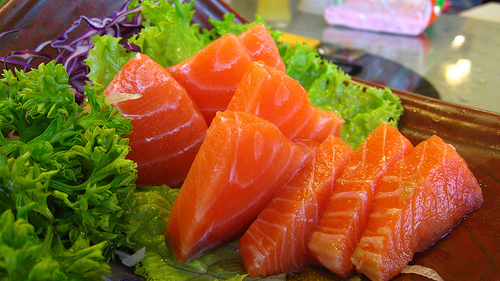當前位置: Language Tips> 雙語新聞
Sushi's secret: Why we get hooked on raw fish
分享到

|
Raw fish is sizzling hot right now. Los Angeles has brand new bars devoted to an Italian style of raw fish, called crudo. President Obama kicked off his visit to Asia last month noshing nigiri at Jiro's famous sushi bar. And back in December, The New York Times named Sushi Nakawaza as its top restaurant of the year. But why do so many of us find utter bliss in eating raw sea creatures but aren't so inclined to chow down on uncooked birds, cows or pigs? A big part of it is gravity — or the effective lack of it in the ocean, says biophysicist Ole Mouritsen, author of Sushi: Food for the Eye, the Body and the Soul. "Fish are so soft. You can stick your finger through their muscles," he says. "Try doing that with a chicken or cow. Fish muscle is very different than that in land animals." Why? Because fish can afford to be lazier than terrestrial animals. Fish essentially float all the time. So their muscles don't work constantly to fight gravity. "Fish don't have to support their body weight," Mouritsen says, "so their muscle fibers are shorter and less tough than those in land animals." The same goes for the connective tissue holding the muscle fibers together: It's delicate and weak. The result? Fish has a silky, smooth texture when it's raw, and a flaky, light texture when it's cooked. By contrast, "Land animals — like ourselves — are always working to keep themselves upright and keep their shape," Mouritsen says, so our muscle fibers are thicker, tougher and firmer. The result is a ropy, chewy — and less appetizing — texture when the meat is raw. Cooking softens the connective tissue in meat and improves its texture (it also makes it juicy and flavorful). In general, the more a muscle works, the tougher, more iNews,雙語新聞,雙語,it gets, Mouritsen writes in his book. This idea explains why the belly of the tuna, known as otoro, is exceptionally soft: The belly of the fish is the laziest muscle of them all. "In contrast, those muscles that are more active in a tuna, say the ones in its fins and tails, are a bit more chewier than other muscles," he says. Under a microscope, fish, chicken and other meat muscles look similar, with long, parallel fibers, like ropes, stretched out and tied together. But when you zoom in a little closer, the fish muscles look like the Kate Moss of the bunch: Their fibers are slimmer, shorter and more delicate than the others. The muscle properties of fish also explain the rainbow of colors you see at a sushi bar. "Fish that are constantly on the move — say, a tuna — have muscles that are always working and burning carbohydrates aerobically," Mouritsen says. The muscles need oxygen to make energy. And the molecule that carries oxygen to muscle contains iron. Guess what color iron is in the fish? Red. In contrast, fish that mostly hang out in one place or on the bottom of the ocean — say, for instance, flounder — have muscles that don't rely on oxygen to create energy. No oxygen means no iron to carry it, which means the muscles tend to be white. (Of course, most fish have a mixture of these two type of muscles and thus can look red, white or pink.) So what about the pinkish-orange color of salmon? That's a special case, Mouritsen says. "The coloring is due to what salmon eat: shellfish that are enriched with a pigment that's related to carotene in carrots, called astaxanthin." This pigment creates the characteristic bluish-gray or green color of raw shrimp and crabs. The molecule turns bright pink or orange when the salmon eats the shellfish or we cook it. |
生魚片現(xiàn)在可是炙手可熱。 洛杉磯新開了許多餐館,專賣一種叫做克魯多(Crudo)的意式生魚片。奧巴馬總統(tǒng)上個月出訪亞洲期間,也抽空去了著名的數(shù)寄屋橋次郎壽司店品嘗生魚片壽司。而在去年十二月,Nakawaza壽司店被《紐約時報》評為年度最佳餐館。 但為什么我們一方面對生鮮海產(chǎn)品趨之若鶩,一方面又覺得生禽肉、生牛肉或生豬肉難以下咽呢? 生物物理學家奧利·莫里特森(Ole Mouritsen)說,一個很重要的原因就是重力——或者說重力在海里的作用微乎其微。他寫過一本書,叫做《壽司:養(yǎng)眼、果腹又提神的食物》。 “魚類相當柔軟,你可以用手指直穿它們的肌肉,”他說:“你再拿塊雞肉或者牛肉試試,肯定不行。魚類的肌肉和陸地動物的肌肉有很大不同。” 為什么呢?因為魚類的生活比陸地動物“更慵懶”。魚類一直都浮在水中,所以它們的肌肉不用長期對抗重力作用。 莫里特森說:“魚類不用承受自身體重,所以它們的肌肉纖維比起陸地動物更加纖細,也沒那么強健有力。”用于連接肌肉的結締組織同樣柔軟無力。 這樣的特點導致了什么結果?生魚肉如絲般順滑,而熟魚肉輕盈剔透。 莫里特森說,相比之下,“陸地動物——比如我們?nèi)祟悺枰恢北3终玖⒌淖藨B(tài)。”所以我們的肌肉纖維更密集、更強健、更結實。 因此,陸地動物的肉在沒煮熟的情況下韌性大、難咀嚼——而且味道也不好。烹飪可以軟化肉中的結締組織,并且改善肉質(zhì)(還可以使肉變得多汁有味)。 莫里特森在其書中寫道,總體來講,肌肉越用越強健,越用越彎曲。這就解釋了為什么金槍魚的肚子——也就是魚腩——超乎尋常的柔軟。金槍魚肚子上的肌肉是全身活動量最少的肌肉。 他說:“相比之下,金槍魚身上更常用的肌肉,比如魚鰭和魚尾上的肌肉,就比其他部位的肌肉更有嚼勁。” 在顯微鏡下觀察的話,你會發(fā)現(xiàn)魚類、禽類和其他肉類的肌肉看起來差不多,都有長長的平行纖維,像繩子一樣緊緊繞在一起。 但如果再放大看的話,魚類的肌肉看起來就像肌肉界的凱特·摩斯(英國超級模特):比其他肌肉更纖細、更短小、更柔弱。 魚類肌肉的這些特性也解釋了為何壽司里的魚肉看起來五顏六色。 莫里特森說:“一直游動的魚——比如說金槍魚——它的部分肌肉一直在活動,通過有氧運動消耗碳水化合物。” 肌肉需要氧氣來制造能量,而負責輸送氧氣到肌肉里的小分子載體含有鐵元素。猜猜鐵元素在魚肉里呈什么顏色?紅色。 相對而言,像比目魚這種不四處游動或只呆在海底的魚,它們的部分肌肉不需要氧氣來制造能量。沒有氧氣也就意味著沒有鐵元素,也就是說這些肌肉呈白色。(當然,大多數(shù)魚類具有兩種肌肉,因此有的肌肉呈紅色,有的呈白色或粉紅色。) 那鮭魚肉的顏色為什么又粉又橙呢?莫里特森說,這是特例。 “鮭魚肉的顏色取決于鮭魚吃什么:鮭魚吃的甲殼類動物富含一種叫做蝦青素的色素,這種色素和胡蘿卜里的胡蘿卜素有一定聯(lián)系。” 蝦青素讓生蝦肉或生蟹肉呈藍灰色或綠色。當貝殼類動物被鮭魚吃掉或經(jīng)過我們烹飪后,其體內(nèi)的小分子就會變?yōu)榱练凵虺壬?/p> (譯者 Leedish 編輯 丹妮) 掃一掃,關注微博微信
  |
上一篇 : 2014年最有紀念意義的畢業(yè)典禮演講名言
下一篇 : 2014世界杯專題:世界人民看FIFA
分享到
關注和訂閱


翻譯
關于我們 | 聯(lián)系方式 | 招聘信息
電話:8610-84883645
傳真:8610-84883500
Email: languagetips@chinadaily.com.cn